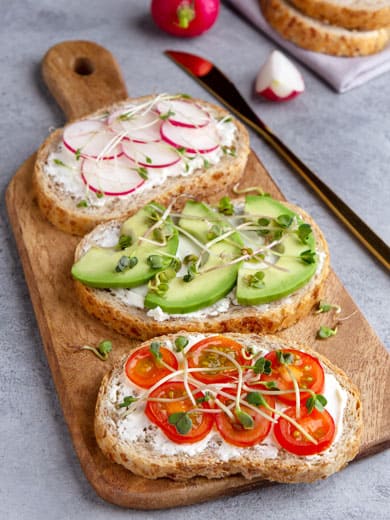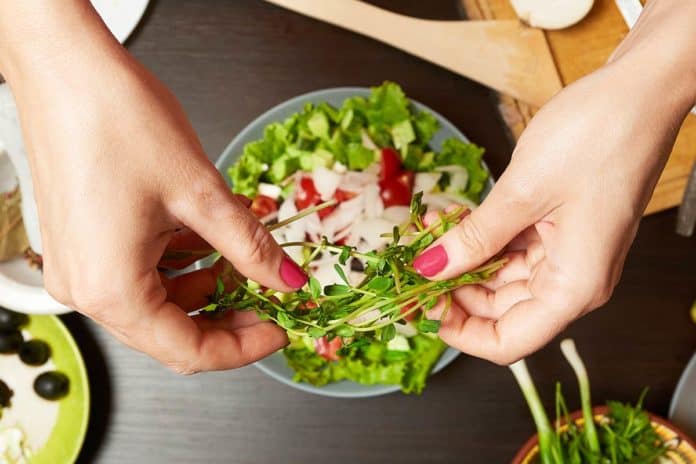When people start eating or growing microgreens, one thing they may worry about is whether or not they’re eating too many. There are some indications that eating microgreens can be risky for your health depending on a few variables in the way they are prepared and grown.
So, is it possible to eat too many microgreens? No, it is not possible to eat too many microgreens as they can be consumed in the same way as any other vegetable. Microgreens are packed full of vital nutrients and vitamins, which is why they are considered a superfood. Unlike sprouts, which can come with a risk of foodborne illness, microgreens are not associated with food poisoning.
Microgreens are a great way to supplement your diet with a variety of tasty and nutritious vegetables. Read on to learn more about why it’s impossible to eat too many microgreens.
Microgreens Are Just Vegetables
Microgreens are salad and vegetable seedlings that have been picked at a very young age, but after they’ve grown larger than sprouts. Microgreens are typically harvested just after the first “true leaves” of the plant have grown.
Microgreens can be substituted safely for any other vegetable or fruit consumed as part of a daily balanced diet. A small amount of them can provide a high boost of vitamins and nutrients, so they are a particularly good choice for those people who are trying to get more green leafy stuff in their diet but don’t want to eat salad after salad in the process.
Fresh plant products such as microgreens and other vegetables provide important roughage and fiber into the diet too, which encourages healthy bowel movements and helps suppress appetite. That means the more microgreens you eat, the more likely you are to fill up on something healthy instead of something that is high-calorie junk with a low nutritional value.
RELATED: The 14 Most Nutritious Microgreens to Grow and Eat
Can Microgreens Make You Sick?
Because they are just another kind of edible vegetable, microgreens are safe to eat even in large quantities as long as they are properly washed to prevent the spread of foodborne illness. Though microgreens are not known to be a common source of food poisoning, there is always the potential for cross-contamination of raw greens during food prep that could cause someone to become sick.
Can You Eat Microgreen Roots?
Technically microgreen roots are edible, but since that is where the most chance of foodborne illness is introduced, it is not recommended that microgreens roots are eaten at all. Instead, microgreens should be harvested with scissors or shears by cutting them from the root system when they are ready for picking and packaging or eating straight from the garden.
In fact, only eating the leafy part of microgreens and removing the sprouted roots cuts down the chance of foodborne illness by half. This is one of the main reasons why microgreens are safer to eat than sprouts from a food safety perspective.
How Many Microgreens Can I Eat?
The short answer is, “As many as you want.” But realistically, the USDA recommends that the average adult eat anywhere from five to thirteen servings of fruits and vegetables a day, all of which could be microgreens if you’re really wanting to eat a bunch of them.
The great thing about microgreens is that because they are so versatile, they can be somewhat easier to work into different kinds of meals than other forms of fruits and vegetables. They can be used in either savory or sweet dishes. There are so many varieties of microgreens that even if you don’t like one type, there’s bound to be another kind you’ll like better.
How Do I Eat More Microgreens?
Incorporating more microgreens into your diet is easy enough. Microgreens can be served raw in salads or sandwiches, used as a garnish for roasted meats and soups, or blended into juices and smoothies. The best way to get more microgreens in your diet without feeling like you have suddenly transformed into a guinea pig is to just incorporate them gradually into your normal meals.

Since microgreens tend to have either complementary or very neutral flavors that don’t clash with other foods much, it is easy to add them to many of your regular meals. Here are some common foods that can be supplemented with microgreens for a boost of color, crunch, and flavor:
- Stir-fries
- Salads
- Wraps
- Mixed into pasta
- Served on sandwiches
- Pizza topping
- Tacos
- Omelets
- Sushi
- Bruschetta
Basically, anywhere you’d typically use shredded lettuce or salad greens in a recipe, you can easily substitute microgreens for a higher dose of vitamins and minerals. Microgreens have so many textures, colors, and flavors that it is easy to find combinations of them that work well with virtually any meal. Used as a bright and visually interesting garnish, they can be incorporated into practically any dish.
RELATED: 35 Tasty Ways to Use Microgreens
You Should Probably Eat More Microgreens
The USDA reports that only one out of ten adults meet their daily recommended servings of fruits and vegetables for the day, which is a large contributing factor to poor health in many developed countries. If anything, people should be looking to incorporate more microgreens into their daily diets, not less.
That means one out of ten people not only can eat more microgreens than they currently are, but they should definitely go out of their way to eat more. If you’re one of the people who have a hard time incorporating fresh vegetables into your daily diet, microgreens are a wonderful way to sneak healthy food into a regular eating pattern which otherwise is probably pretty vegetable deficient.
It’s pretty hard to eat too many microgreens based on the fact that they are often only ingested in small amounts as a garnish or condiment. You would have to eat bowls and bowls of the stuff to make it an unbalanced part of your diet, and unless you’re avoiding sources of other vital nutrients such as protein, microgreens should not pose any health problems related to overconsumption.
Microgreens and Food Poisoning
Like salad greens, microgreens are often ingested completely raw and depending on where they are sourced and how they are prepared, this can potentially introduce foodborne illnesses such as E. coli, listeria, or salmonella. Salad greens also have a bad rap for contamination by pesticides in commercial agriculture.
The good news is that microgreens are less susceptible to being contaminated by foodborne illness for a few reasons:
- They aren’t grown in the warm, humid conditions that encourage the kind of environment that bacteria grow well in. This is in contrast to sprouts, which are called out by the CDC as a potential form of food poisoning.
- Many microgreens are easily grown at home on a windowsill or in a small garden, which makes it much easier for the grower to control hygiene around the growth station. This is in contrast to salad greens grown in industrial agricultural conditions, where sanitation is a much bigger concern and you’re not sure where your vegetables are coming from.
- Microgreens are most often grown organically without pesticides since they are grown easily indoors. This makes them less of a risk of pesticide ingestion than other forms of fruits and vegetables which are commercially treated during their growing process. Many raw vegetables other than microgreens such as kale are notorious for their levels of pesticide contamination.
In other words, not only is it almost impossible to eat too many microgreens (you’ll get bored of them way before you hit your physical limit) there’s a lot of good cases for eating them instead of normal salad greens or sprouts.
Microgreens Are A Healthy Treat You Need More Of, Not Less
If you’re one of the nine out of ten adults who doesn’t eat enough vegetables daily, microgreens are a fantastic and tasty way to sneak more of the green stuff into your food without feeling like you’re being deprived. They are easily grown in most households and just a few handfuls of the stuff can significantly improve your daily nutritional profile if you eat them regularly.
Microgreens are one of the easiest methods for injecting more nutrition into less nutritious or “comfort food” meals that are often more heavy on grains, fats, meats, and dairy than they are vegetables.


